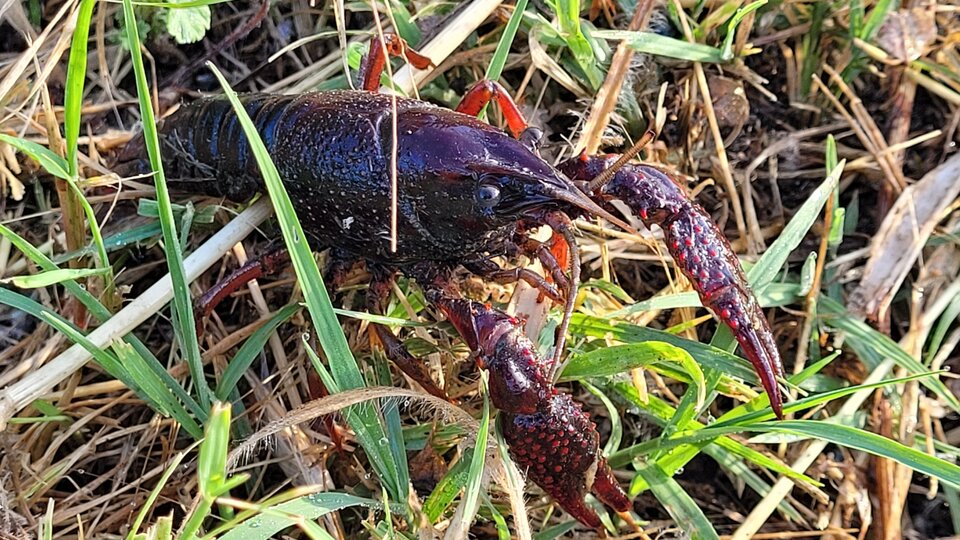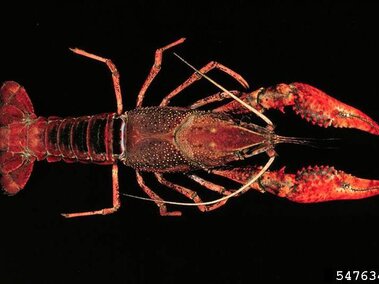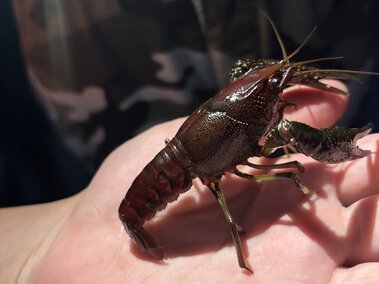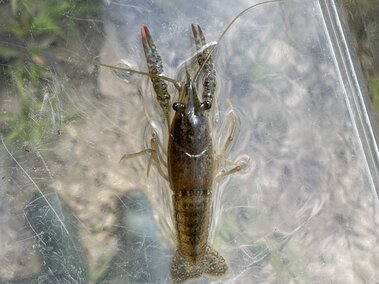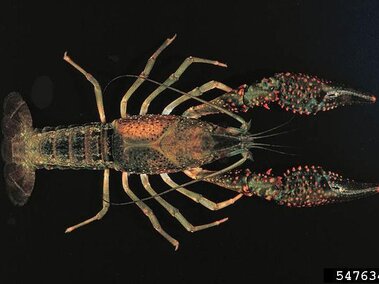General Information
Species Name: Procambarus clarkii
Also Known As: Louisiana crayfish/crawfish, Louisiana lobster, red swamp crawfish
Family: Cambaridae (Freshwater Crayfish)
Life Span: 2 to 5 years
Life Cycle: It matures when it reaches a size between 6 and 12.5 cm. A 10 cm female may produce up to 500 eggs, while smaller females may produce around 100 eggs. Eggs are 0.4 mm, and newly hatched crayfish remain with their mother in the burrow for up to eight weeks and undergo two molts before they can fend for themselves. Populations contain individuals that are incubating eggs or carrying young throughout the year. This allows the crayfish to reproduce at the first available opportunity. In places with a long flooding period, greater than 6 months, there may be at least two reproductive periods in autumn and spring.
Origin: North America (Gulf coastal plain from the Florida panhandle to Mexico; southern Mississippi River drainage to Illinois)
Injurious: No
Category 2: Priority Aquatic Invasive Species
Why Are They Invasive?
Red swamp crayfish are omnivorous, feeding on aquatic plants, snails, insects, fish and amphibian eggs and young. They have been found to reduce amphibian populations in California and Spain through direct predation and competition for habitat. Populations have also led to declined native crayfish species in Europe through competition and because they often carry the crayfish fungus plague.
What Do They Look Like?
The red swamp crayfish are dark red with raised bright red spots covering the body and long, narrow claws and a black wedge-shaped stripe on the top of the abdomen. They may vary in length between 2 to 5 inches. A genetic mutation may occasionally turn the body and claw blue. Juveniles are often more grey.
Photos
Where Do They Live?
Red swamp crayfish are very abundant in standing bodies of water, ponds, swamps, sloughs, sluggish ditches, and slowly flowing streams. They tend to prefer muddy or sandy substrates where there is plenty of organic debris, such as leaves, logs, and sticks. They can tolerate brackish water, unusual for most crayfish. They also have been recorded to have the ability to cross several miles of relatively dry ground and can burrow into the ground during extended dry periods.
How Do They Spread?
They were probably introduced through aquaculture, as they are a popular food worldwide.
How Do I Control Them?
Management of invasive aquatic animals involving either mechanical removal or application of chemicals to public waters requires a permit. Contact the Contact the Nebraska Game and Parks Commission for more information.
CLEAN your watercraft, trailer, angling gear and other equipment. Remove all aquatic vegetation and animal species from your equipment.
DRAIN your watercraft at the ramp by removing the boat plug and draining all live wells and ballast tanks.
DRY your watercraft, trailer and other equipment for at least 7 days before visiting another waterbody.
DON'T DUMP BAIT. Dispose of bait by emptying bait buckets on dry land, away from waterbodies or in a trash receptacle. Moving a live organism from one waterbody to another is illegal, even if you are planning to use the organism as bait.
DON'T LET IT LOOSE. Do not release or transport exotic or non-native fish species to new ecosystems. It is unlawful to release any aquatic species into a waterbody other than the one from which it was harvested. Doing so can promote the spread of AIS.
What Should I Do If I See Them in Nebraska?
If you see red swamp crayfish in Nebraska, you should report them to the Nebraska Game and Parks Commission's Aquatic Invasive Species (AIS) Program using their AIS Report Form. For guidance on what information to include in your report, check out our reporting tips.
References and More Information
Center for Invasive Species and Ecosystem Health
Midwest Invasive Species Information Network
Nebraska Game and Parks Commission
Smithsonian Environmental Research Center
Summary of Species Currently Listed as Injurious Wildlife under (18 U.S.C. 42) Lacey Act
